#Gough Island
Explore tagged Tumblr posts
Text
" Dreamy Kelp Scenes " //© James Lowe
Music: Azap - One More Light
#kelp forest#Gough Island#Tristan da Cunha#United Kingdom#nature#Underwater Photography#Marine Biology#scubadiving#diving#4K#8K#12K#fpv#reels#wanderlust#aesthetics#explore#follow#discover
155 notes
·
View notes
Photo

Gough Island (a British territory in the southern Atlantic Ocean).
There is a job offer for an ornithologist to work there for 13 months. It's only 1500mi (2400km) from the mainland and has no airport. Ah, and you have to control the mice population. Are you interested?
93 notes
·
View notes
Text
CW for animal death and if you click on some of these stories there are some gruesome pictures.
That is Marion Island, between South Africa and Antarctica. And yes these are house mice (Mus musculus), not rats.
And also Gough Island in the South Atlantic

location of these two islands, for reference. Probably happens on others too, but both of these were reported on recently on Live Science.
In this article it explains that Marion Island is the third place mice have been observed attacking and killing adult albatross, the previous two being Gough Island and Midway Atoll in the Pacific.

God the world is awesome
#albatrosses#mice#Mus musculus#invasive species#seabirds#Gough Island#Marion Island#Midway Atoll#animal death#gruesome images in articles
24K notes
·
View notes
Text

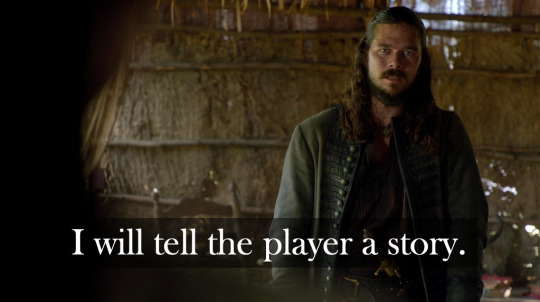

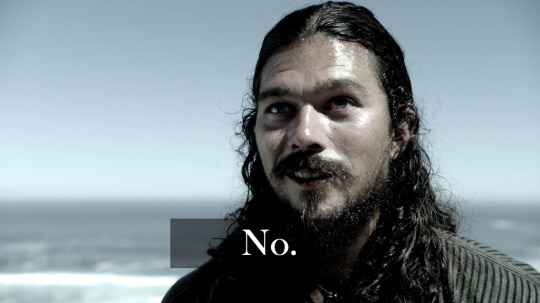
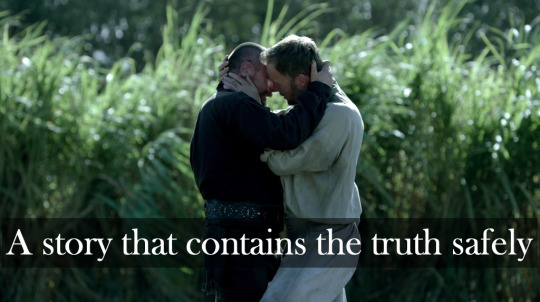
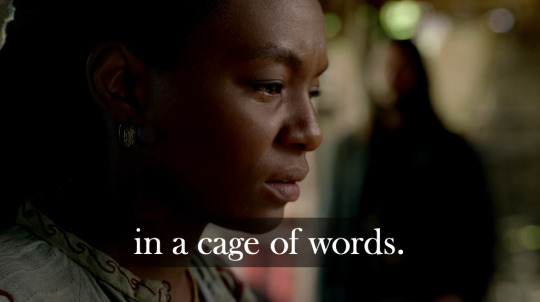

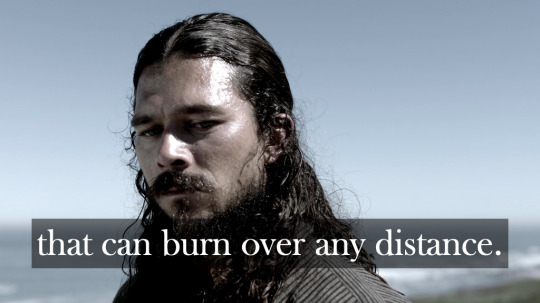
-Julian Gough, "End Poem"
[Image ID: 8 photos from Black Sails overlain with text. Image 1: Flint looks curiously at Silver as they stand on a hilltop on Maroon Island in a flashback. Image 2: Silver speaks to Madi, whose back is just visible on the left of the image, in her room in the Maroon camp. Image 3: Silver points a gun at Flint in the woods on Skeleton Island. Image 4: Close-up of Silver's face looking at Flint on the hill in the Maroon Island flashback. Image 5: Flint and Thomas embracing in a field. Image 6: Close-up of Madi's heartbroken face in her room in the Maroon camp with Silver just visible in the background. Image 7: A group of 4 pirates stare at something off-screen in the woods on Skeleton Island. Image 8: Close-up of Silver's sad face in the flashback on Maroon Island. The text reads, "The player is growing restless. I will tell the player a story. But not the truth. No. A story that contains the truth safely, in a cage of words. Not the naked truth that can burn over any distance." end ID]
#even though i don't actually think silver killed flint but he definitely lied about something#but anyway#oh minecraft end poem we're really in it now#actually i might make that its own post#black sails#john silver#black sails edit#sam speaks
180 notes
·
View notes
Text






On 2nd November 1902 The Scottish National Antarctic Expedition led by William Speirs Bruce set sail from Troon on the "Scotia".
In 1895, the continental Antarctica was entirely unknown, as was much of its coastline. At the 6th International Geographical Congress a motion was adopted declaring "the exploration of the Antarctic Regions" to be "the greatest piece of geographical exploration still to be undertaken".
During the following 25 years, no less than sixteen major expeditions were to be sent to Antarctica during an episode widely referred to as 'The Heroic Era of Antarctic exploration'. Amongst the various national expeditions organised was one from Scotland. Its leader, William Bruce, was one of the most capable polar scientists of his generation. Today, his name is less well-known than those of his contemporaries Robert Falcon Scott and Ernest Shackleton.
The Scotia reached the Falkland Islands in December1902, continuing south to make the first oceanographic exploration of the Weddell Sea. Scotia, with a complement of 33, wintered at Laurie Island, South Orkney Islands. Here a meteorological observatory "Omond House" was established on 26th March 1903. The island was mapped, and when the engineer of Scotia, Alan Ramsay, died during the Antarctic winter, his grave became the first in the island cemetery.
Scotia revisited the Falkland Islands in December 1903 then called at Buenos Aires, Argentina, where transfer of the meteorological station to the Argentine government was arranged through the British Legation. Scotia sailed to the Falkland Islands for a third time then back to Laurie Island where the transfer was made on 22nd February 1904.
This second southern voyage saw the discovery of the northern part of Caird Coast, Coats Land (named for two brothers who had funded much of the expedition). With no landing possible on the Antarctic continent the ship then called at Gough Island and Cape Town, South Africa. A comprehensive scientific programme was conducted throughout the expedition; cine photographs and sound recordings were made.
13 notes
·
View notes
Text

The northern rockhopper penguin almost exclusively breeds on two islands in the Atlantic, Tristan da Cunha and Gough Island. There is still some debate as to whether the northern and southern rockhoppers are subspecies or separate species, but analysis of mitochondrial DNA indicates the latter.
25 notes
·
View notes
Text
Happy world penguin day!!

I am going to go over some interesting penguins, they could be interesting because of their names or adaptions.
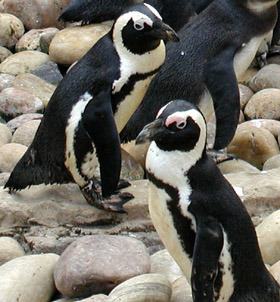
These guys are the African Penguins. The African Penguin is the only one of 17 penguin species that lives in Africa. This penguin is also known as the Jackass penguin because they have a noisy squawks. These squawks sound like the braying of a donkey therefore getting the nickname the Jackass penguin. In the language Afrikaans they call the African penguins brilpikkewynn (pronounced bril as in brilliant-puh-kuh-vain), this translates to English as braying penguin.
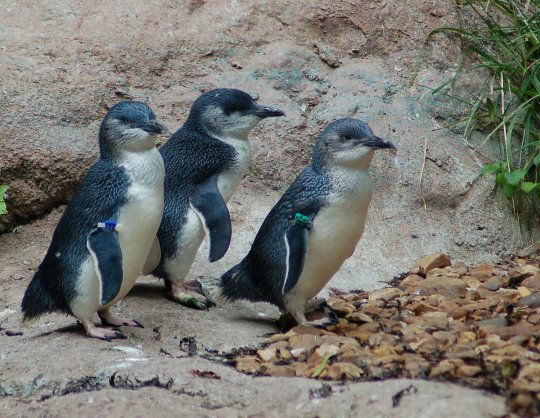
New Zealanders call these penguins Little Blue Penguins or just Blue Penguins. Australians call them Fairy Penguins.thw names come from the small size the fairy penguins have. Fairy penguins are actually the smallest species of penguin. The fairy penguins have indigo-blue or slate-blue feathers on their backs as you can see in the image above. The scientific genus name (Eudyptula) means good little diver. Fairy penguins do not migrate. They live year-round on their mainland or island locations in the southern hemisphere

Some species of penguins propose to each other with a pebble. Adélie penguins are actually one of those penguins. When the two penguins are dating, the male penguin will give the female a pebble. If the pebble is accepted by the female the two penguins will mate for life. When Adélie penguins mate for life and return to each other at the same nest every year. The nest will be a pile of pebbles.

The population status of eastern rockhopper penguins is unknown. The eastern rock hopper penguins are located on several islands in the Indian and Pacific oceans. The penguins specifically live in sub-artic locations, such as the Crozet and Kerguelen islands. Eastern rockhopper penguins spend most of their lives at sea and only return to land to molt and breed.

At least 85% of northern rockhoppers are located on the islands of the Atlantic ocean Gough and Tristan da Cunha. of the Tristan da Cunha archipelago and Gough Island in the Atlantic Ocean. The population of the Northern rockhoppers has decreased about 90% since the 1950s.
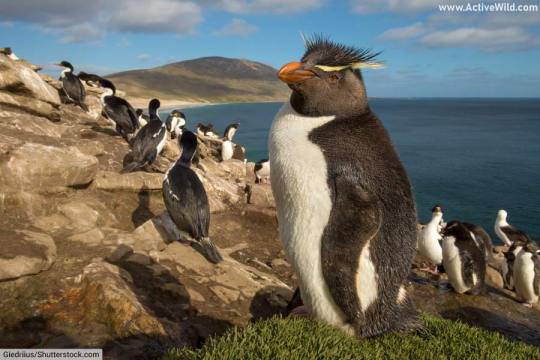
The Southern rockhopper penguins are classified as vulnerable and have decreasing population size. This species of rockhopper penguins live on the coastlines of Chile and Argentina, as well as the Campbell island in New Zealand. The Southern rockhoppers are found on several other islands in the Pacific, south Atlantic and Indian oceans. The Southern rockhoppers have a narrower stripe of yellow over their eyes than the Northern rockhoppers.

The Magellanic penguin is the most common type of banded penguin. They are a medium to large penguin that have a thick black line running across their white chest. Magellanic penguins have white border surrounding their face. During breeding season Magellanic penguins are found on the Falkland Islands as well as the coast of southern south America. In the winter they migrate as far north as northern Brazil.
There are also some gay penguins. People have served penguins engaging in homosexual behavior since as early as 1911. The first documented case of homosexual penguins was not released to the public until a century later due to the report being "considered too shocking for public release".
#magellanic penguin#jackass penguin#african penguin#fairy penguin#little blue penguin#adélie penguin#rockhopper penguin#northern rockhopper penguin#Southern rockhopper penguin#eastern rockhopper penguin#world penguin day#cute penguins#gay penguins#homosexual penguins
25 notes
·
View notes
Text
i keep spontaneously remembering that the south african national antarctic program takes the whole "this is basically a space expedition" thing a step further by having patches for each expedition
i should check if the team for Gough Island Expedition 69 has a team picture yet
5 notes
·
View notes
Text
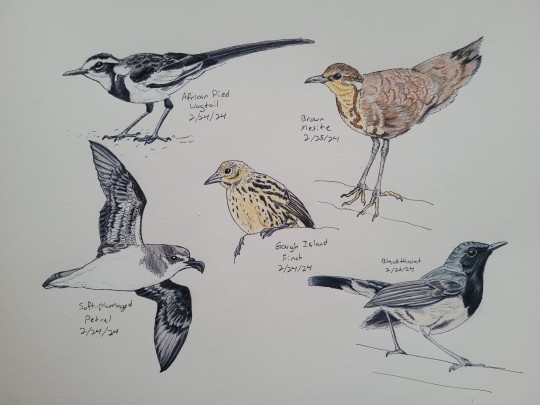
February 24-25, 2024
- African Pied Wagtail
- Brown Mesite
- Gough Island Finch
- Soft-plumaged Petrel
- Blackthroat
Not many pictures of the gough island finch.
4 notes
·
View notes
Text
I got lost on google earth

and I've found a guy, "Kelvinn Feltrin" on Google Reviews (my favorite points-based antisocial network), operating in the hyperniche comedy genre of "reviews of tiny Pacific island amenities"

And he's pretty good at it, actually, multi-oceanic (Pacific, Atlantic, and even Antarctic oceans), generous ratings, solid lil quips that perfectly accentuate the absurdism of riding a bike 1800 miles into the Atlantic

but what's this?

Gough Island Weather Station? Never heard of it, what's it like?
Gorgeous.



(pictures courtesy of Rhiannon, who did a great job capturing the heather and had an enviable December vacation)
But what I need to know, Ferris Kleier, German tourist, owner of the only review of the Khan Bank ATM in a tiny Mongolian town 200 miles east of Ulan Batar (four stars), desperately and without delay-

what is this orb on the roof of the Gough Island weather station for and where can I buy one
#sometimes i get lost on google earth#i think this is what google earth is for#ferris kleier also rated the DHL corporate office in america 3 stars with no explanation#curious what that was about
2 notes
·
View notes
Text
" Urchins & Anemones " //© James Lowe
Music: Susanne Sundfør - Lys
#kelp forest#Gough Island#Tristan da Cunha#United Kingdom#nature#Underwater Photography#Marine Biology#UrchinsAnemones#Anemones#Algae#4K#8K#12K#fpv#reels#aesthetics#wanderlust#explore#follow#discover
86 notes
·
View notes
Text
Disney Month The Sword and the Rose
For the third review of Disney Month ,we shall look at the Sword and the Rose

in this 1953 film Mary Tudor ( Glynis Johns) falls for a new arrival at court Charles Brandon (Richard Todd ) ,but her brother King Henry VIII (James Robertson Justice ) seeks to wed her to the French king , Louis XII (Jean Mercure) ,all while the Duke of Buckingham (Michael Gough ) also pines for her
Third in a series of films Walt Disney made in England which included Treasure Island ,The Story of Robin Hood and his Merry Men , and Rob Roy Highland Rogue .....I went into this movie COMPLETELY blind ,all I knew was Michael Gough and Glynis Johns were in it and it was one of Disneys early British made films before he tackled the big budget 2000 LEagues under the Sea .I didnt know the setting,didnt know the plot ,and didnt even know what genre it was ,just assuming it was a swashbuckling adventure.....And what I got in stead was a period piece romance with adventure elements,,,,,,And I loved it ,this is such a hidden gem
This is another film that doesnt feel very Disney to me ,it feels like a normal period piece movie(Though I dont know how accurate it is but accuracy is not this films focus,it is being entertaining ).I thought Glynis Johns delived a magnificent performance,in fact this miht be my favorite role I have seen her play ,in that we root for her even when she gets a bit devious .James Robertson Justice is both a good antagonist while also bringing levity to the film as King Henry VIII .Michael Gough as the Duke of Buckingham ,behind Glynis Johns,is my second favorite performance in the film cause I didnt know what direction they would take ,so when his true colors are revealed it is very effective ,and it might be one of my favorite roles I have seen Gough play .I will say Richard Todd while good,is a bit flat compared to the other actors ,and I didnt quite buy his romance with Mary till the end
I will say as a romance its just OK,,,,,Buuuuuut this appeals a ver specific thing I like which is "DOYAL DRAMA" .For some reason I love media depicting royals make deals, and backstab and all that stufff ,so I think it is a good period drama in that regard.It also has a pretty good final fight and the film opens with Michael Gough AKA Alfred Pennyworth wrestling people,which not something I expected to see but is now something I'm glad I have .I think the costume and production values are all great ,and I was far more invested in the story then I thought I would be
I think this is a very good hidden gem that I reccomend
@ariel-seagull-wings @amalthea9 @princesssarisa @the-blue-fairie @themousefromfantasyland @filmcityworld1 @marquisedemasque @angelixgutz @goodanswerfoxmonster
6 notes
·
View notes
Text
"....in response to the American settlement of Oregon and the news of gold in California, the British government established the proprietary colony of Vancouver Island. Then, in 1858, following a rush of underemployed miners from California to the Fraser River, it established the crown colony of British Columbia. As Daniel Clayton puts it, "native space was reproduced as an absolute space of British sovereignty," (2000, 236) although initially, in the aftermath of the Treaty of Waitangi and judicial rulings in New Zealand, officials in the Colonial Office were uncertain about the extent to which British sovereignty in these colonies was burdened by native title (Harris 2002, 15-16).
With the creation of these two colonies, land was framed in a new problematic. Colonies entailed settlers, and settlers required land, which could be got only by dispossessing native people. A relationship based on trade was replaced by one based on land. As their land was taken away, native people had to be put somewhere. A solution with many precedents in other settler colonies was to put them on reserves. Dispossession began in the 1850s and continued through the rest of the century. Physical violence, the imperial state, colonial culture, and self-interest all underlay it
The establishment of colonies on Vancouver Island and the mainland changed the nature of violence there. It had long accompanied the fur trades. . . in the interior, an axiom of the land-based fur trade was that perceived assaults on the personnel or property of the traders would be met with quick, spectacular displays of violence-sovereign power in the Foucaultian sense, though without a validating regime of rights (Harris 1997, ch. 2). Nor was the gold rush peaceable...
...
But with the creation of settler colonies, a new level of organization and calculation - the British military-was built into the equation of violence (Gough, 1984). British warships operated along the coast; a detachment of Royal Engineers was sent out to survey land and maintain order. Such power was more often displayed than used - a few quick and very public hangings of suspected murderers after summary trials on the quarterdeck of one of Her Majesty's warships, or a few villages shelled and destroyed - spectacles intended to instill fear. Officials considered such power "a grand persuasive." Some held that it saved lives by preventing settler-native wars. Frequently, they judged it sufficient to anchor a warship just off a native village and ostentatiously prepare the guns.
In the interior, the space beyond the reach of a ship's guns, the military equation was more balanced. In the 1870s, as settlers were moving in and preempting land, many natives leaders talked of war. Settlers feared, perhaps with justification, that a native uprising could wipe all of them out in a single night. But, as the chiefs knew, a short-term victory was one thing; keeping at bay settlers and the armies that, sooner or later, would back them up was quite another. The results of wars across the border in which native warriors (some from British Columbia) had fought federal U.S. troops, was evidence in hand. Those who counseled war did so out of desperation. One chief put it this way:
A war with the white man will end in our destruction, but death in war is not so bad as death by starvation."
Overall, the balance of physical power lay overwhelmingly with the state.
...
As liberal humanitarian sentiments about the essential oneness of human kind and the opportunity to create a world of civilized, Christian people faded, responsible government came to dominate protection in Colonial Office thought (Metcalf 1996; Porter 1999). In settler colonies, where access to land was the predominant issue, only a hollow form of responsible government would exclude land policy from colonial jurisdiction. In effect, by the late 1840s and 1850s, the Colonial Office had no clear, consistent native policy. As a result, when the colony of Vancouver Island was created, it was readily inclined to turn over the management of native people to the Hudson's Bay Company (which, it thought, had handled them much better than the Americans) and to rely on the judgment of the fur trader-cum-governor (George Douglas), who managed both colonies until his retirement in 1864. Thereafter, land policies were formulated by local settler politicians. The Colonial Office hardly interfered, and in 1871 when British Columbia became a Canadian province, land policy, now constitutionally a provincial responsibility within the Canadian confederation, remained in the hands of these same politicians. The state created a framework for the ordered development of a settler society, but did not, itself, provide the momentum for the development of that society or for the dispossessions and repossessions of land that accompanied it. When power passed to local politicians, they reflected the values and interests of their constituents.
...
An Indian reserve commissioner, charged with laying out reserves, said this to a native audience on Vancouver Island in 1876:
Many years ago you were in darkness killing each other and making slaves was your trade. The Land was of no value to you. The trees were of no value to you. The Coal was of no value to you. The white man came he improved the land you can follow his example-he cuts the trees and pays you to help him. He takes the coal out of the ground and he pays you to help him-you are improving fast. The Government protects you, you are rich-You live in peace and haveeverything you want.-(cited in Harris 2002, 108)
At the time, few if any white settlers would have disagreed. There were arguments about how quickly native people could be assimilated and, therefore, about how much land should be allocated to them. Some settlers, biological racists to the core, considered natives utterly lazy, degenerate, and unredeemable; but a few found much to appreciate or pity in native lives, were well disposed toward native people nearby, and now and then supported their pleas for more reserve land. But even kindness tinged by an educated, romantic appreciation of nature and, therefore, of lives assumed to live close to nature was situated within the assumptions of the civilization/ savage binary."
- Cole Harris, "How Did Colonialism Dispossess? Comments from an Edge of Empire," Annals of the Association of American Geographers, Vol. 94, No. 1 (Mar., 2004), p. 169-171.
#settler colonialism#settler colonialism in canada#dispossession#violence of settler colonialism#land theft#empire of theory#canadian history#indigenous people#first nations#reading 2024#cole harris#vancouver island#colony of vancouver island#reservation system#royal navy#british empire#canada in the british empire
1 note
·
View note
Text
6 Most Popular Restaurants in Hong Kong
Hong Kong is a bustling city that is home to many different cultures, cuisines and traditions. It is located on China's southeast coast. This city is well-known for its breath taking skyline, busy harbour and rich history. It is also a culinary paradise that draws travellers from all over the world. Hong Kong, a special administrative territory of China is known for its distinctive fusion of Eastern and Western cultures which is evident in the wide range of cuisines it offers. Hong Kong offers a wide variety of cuisine to suit every taste, including Michelin-starred dishes, modern fusion, and traditional dim sum.

Any tour to Hong Kong must include a gastronomic exploration as the city is home to some of the world's most renowned restaurants. Hong Kong's food industry is as dynamic as the city itself offering everything from spectacular skyline views at upscale restaurants to hidden gems nestled away in its energetic neighbourhoods. We'll walk you through six of the most well-liked eateries in Hong Kong in this guide, which ought to be on the itinerary of any food enthusiast.
Here are the 6 Most Popular Restaurants in Hong Kong
1. Racines:

Racines is a quaint fine dining café on Upper Station Street in Sheung Wan. The name Racines translates to "roots" in French. With just 14 seats Racines provides a cozy dining experience under the direction of chefs Adriena Castillo and Romain Dupeyre, who were both previously employed at the two-Michelin-starred La Chévre d'Or on the French Riviera. For those looking for sophisticated French cuisine in Hong Kong, this restaurant is a must-visit. It serves French classics with a contemporary touch and its seasonal five- and seven-course tasting menus make use of French and locally sourced ingredients.
2. The Chairman Restaurant:
It is a classy eating venue that serves authentic Cantonese food. It is located at the intersection of Gough Street and Kau U Fong. The restaurant was founded in 2009 by seasoned restaurateur Danny Yip, and since then, it has been committed to conserving the culinary customs of the Guangdong diaspora and Hong Kong. The Chairman is well known for its dedication to using traditional cooking methods and fresh, locally produced products, providing a genuine sense of Hong Kong's rich culinary legacy.
3. Mora:

Chef Vicky Lau who is well-known for her Tate Dining Room founded Mora her second restaurant. Mora is a French-Chinese fusion restaurant with a seasonal menu that showcases the diversity of soy. It is located in Hong Kong. In keeping with Chef Vicky's heritage Mora offers a distinctive and carefully crafted dining experience that embodies both traditions with Head Chef Percy Ho spearheading the culinary staff.
4. Ming Pavilion:

The newest culinary treasure on Island Shangri-La, Ming Pavilion takes guests on an experiential culinary tour of the rich culinary traditions of Fujian, a coastal province in southeast China. Fujian which is well-known for its lush farms and close proximity to the sea, is home to Hokkien cuisine which is celebrated at Ming Pavilion using age-old methods .The restaurant honours the region's culinary legacy by providing a varied and genuine eating experience that brings the flavours of Fujian to life.
5. Amber:
Amber is a classy restaurant that reinvents French cuisine with a contemporary touch. It is housed at The Landmark Mandarin Oriental in Hong Kong. Under the direction of Chef Richard Ekkebus, Amber specializes in creating inventive, airy and exquisitely presented dishes by combining quality food with classic French cooking methods. With specialties like takaba grouper with tete de veau and crispy kataifi-covered frog legs the restaurant has won multiple accolades for its innovative take on haute cuisine.
6. Caprice:

A well-known French fine dining restaurant offering an elegant culinary experience Caprice is tucked away within the upscale Four Seasons Hotel in Hong Kong. Along with an exceptional wine list and an array of gourmet cheeses the restaurant offers a vegetarian cuisine. The adjoining Caprice Bar offers a cozy setting for savouring fine wines and seasonal cocktails, making it the ideal location for an elegant dining experience. Chef de Cuisine Guillaume Galliot incorporates international flavours into classic French cuisine by drawing on his extensive travel experiences.
Conclusion:
In summary, Hong Kong's eating scene offers a superb variety of culinary experiences that satisfy all tastes reflecting the city's dynamic cultural diversity. Every restaurant exhibits a different fusion of history and innovation from the chic French elegance of Racines and Caprice to the inventive French and Chinese cuisines of Mora. These restaurants offer a unique and unforgettable culinary experience, whether you're savouring the real Cantonese food at The Chairman Restaurant or discovering the rich history of Hokkien cuisine at Ming Pavilion.
If you're thinking about visiting this vibrant city making time to check out these best eateries should be at the top of your list. A Hongkong Tour gives you the chance to fully immerse yourself in the rich history and culture that make this city so unique, in addition to enjoying dining at some of the best restaurants in the world. These six well-liked eateries offer a culinary experience that will make an impression, regardless of your level of culinary expertise or desire to simply enjoy the best of Hong Kong.
0 notes
Text
#2342 - Notogrammitis angustifolia - Strap Fern


'Narrow-leaved' 'Southern-Grammitis'. AKA Asplenium angustifolium, Grammitis magellanica, Polypodium billardierei var. magellanicum , Polypodium magellanicum, Grammitis billardierei var. magellanica, Polypodium poeppigianum, Grammitis magellanica and Grammitis poeppigiana.
An epiphytic fern most often found in beech forests, at least in New Zealand, but the two subspecies have a pretty wide distribution in the Southern Hemisphere, including the cooler parts of SE Australia, and also in Chile, Argentina, Tristan da Cunha, Gough Island, South Africa, and the Chatham Islands.
Very difficult to grow in captivity.
Whakapapa Village, North Island Volcanic Plateau, New Zealand
1 note
·
View note
Text


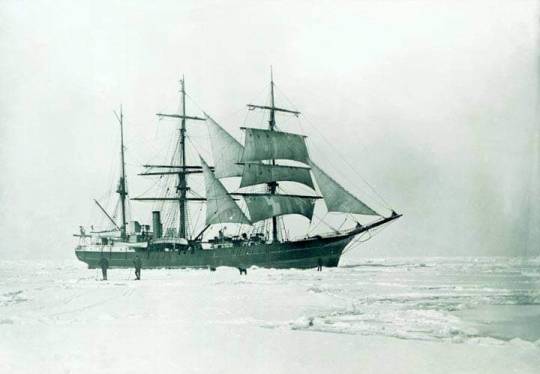

On 2nd November 1902 The Scottish National Antarctic Expedition led by William Speirs Bruce set sail from Troon on the “Scotia”.
I would think not many of you will know of this expedition itself but most of you will have seen the photos of Piper Kerr playing his bagpipes to the indifferent penguin.
William Speirs Bruce work in both the Arctic and Antarctic should see his name ranked very highly, even alongside Robert Falcon Scott, Ernest Shackleton and Roald Amundsen, yet hardly any Scots will recognise his name at first glance.
That is because unlike Scott and Shackleton, Bruce was a difficult man – he may have been on the autistic spectrum – who was wholly dedicated to science and did not seek attention or publicity for his work. Most London newspapers ignored him, and unlike other explorers he had no media sponsor, as we would call them nowadays. Nor did Bruce die or need to be rescued on his expeditions – doing things right was rarely a way to endear yourself to the press.
There have been attempts in recent years, especially during the centenary of the SNAE, to boost Bruce’s reputation. There was also a documentary from the BBC in 2011, but he is still not given the accolades that he surely deserves.
Born in London in 1867 to a Scottish doctor and his Welsh wife, he was given the middle name Speirs. He was sent to boarding school in Norfolk and prepared to study medicine at University College London, but a brief stay at the Scottish Marine Station a floating research laboratory – at Granton Edinburgh convinced him to stay in Scotland.
In 1895, the continental Antarctica was entirely unknown, as was much of its coastline. At the 6th International Geographical Congress a motion was adopted declaring “the exploration of the Antarctic Regions” to be “the greatest piece of geographical exploration still to be undertaken”. During the following 25 years, no less than sixteen major expeditions were to be sent to Antarctica during an episode widely referred to as The Heroic Era of Antarctic exploration. Amongst the various national expeditions organised was one from Scotland. Its leader, William Bruce, was one of the most capable polar scientists of his generation.
The Scotia reached the Falkland Islands in December, continuing south to make the first oceanographic exploration of the Weddell Sea. Scotia, with a complement of 33, wintered at Laurie Island, South Orkney Islands. Here a meteorological observatory Omond House was established on 26th March 1903. The island was mapped, and when the engineer of Scotia, Alan Ramsay, died during the Antarctic winter, his grave became the first in the island cemetery.
Scotia revisited the Falkland Islands in December 1903 then called at Buenos Aires, Argentina, where transfer of the meteorological station to the Argentine government was arranged through the British Legation. Scotia sailed to the Falkland Islands for a third time then back to Laurie Island where the transfer was made on 22 February 1904. This second southern voyage saw the discovery of the northern part of Caird Coast, Coats Land (named for two brothers who had funded much of the expedition). With no landing possible on the Antarctic continent the ship then called at Gough Island and Cape Town, South Africa. A comprehensive scientific programme was conducted throughout the expedition; cine photographs and sound recordings were made.
14 notes
·
View notes